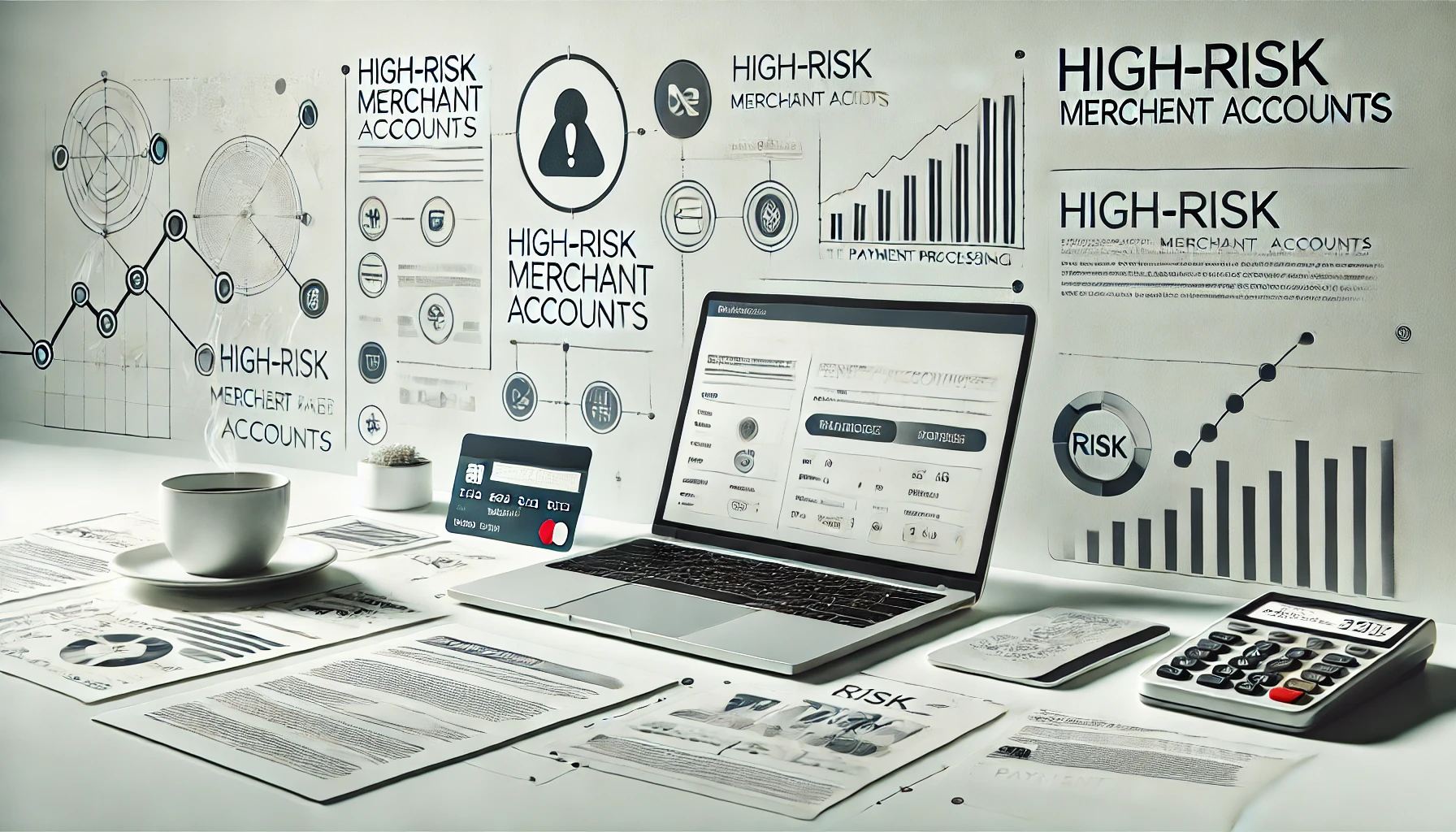What is a High-Risk Merchant Account

What is a High-Risk Merchant Account
As digital payments continue to dominate global commerce, businesses are increasingly searching for cost-effective payment processing solutions. In fact, only 19% of consumers still prefer using cash for payments [1], highlighting the widespread adoption of electronic and digital payment methods. However, not all businesses have equal access to these services. Certain industries are labeled “high-risk” due to the nature of their operations, leading to difficulties in finding payment processors willing to work with them.
A high-risk merchant account is designed specifically for businesses that are considered to have a higher likelihood of fraud, chargebacks, or other financial risks. If your business falls into this category, you may face challenges in securing a payment processor, as many providers prefer working with low-risk industries to minimize their own exposure.
This article will explore what qualifies a business as high-risk, what factors determine risk levels, and how you can find the right payment processing solution for your business.
What Is a High-Risk Merchant Account?
A high-risk merchant account is a payment processing service for businesses that banks consider riskier than standard accounts as they display or are part of industries or sectors that usually display a high volume of chargebacks, financial instability, history of frauds, bad credit ratings, etcetera. These businesses need such accounts to accept debit and credit card payments due to the greater level of risk they pose compared to traditional, low-risk companies.
There is no single authority or standardized framework in the payments industry that universally defines what makes a business high-risk. Instead, each bank or payment processor evaluates risk based on its own criteria.
Some Payment Service roviders explicitly avoid certain industries, while others carefully assess a business’s operations before deciding whether to approve or decline their application. Ultimately, the decision hinges on the processor’s internal guidelines and risk management strategies.

How Are Businesses Assessed As High-Risk?
High-Risk vs Low-Risk Merchant Accounts
While both high-risk and low-risk merchant accounts serve the same fundamental purpose—facilitating payment processing—there are key differences between the two.
Low-risk (or standard) merchant accounts are typically reserved for businesses with stable financial histories, low chargeback rates, and minimal fraud risk. They come with lower fees, fewer financial requirements, and more straightforward approval processes. These accounts are ideal for industries with predictable, low-risk transactions.
On the other hand, high-risk merchant accounts often come with additional fees, more stringent underwriting processes, and reserve requirements. These reserves act as financial buffers to protect the payment processor from potential chargebacks or losses. High-risk accounts may also involve longer settlement periods to manage and monitor transactions more carefully.
How Are Businesses Assessed As High-Risk?
When a financial provider evaluates whether a business is considered high-risk, they assess both the company itself and the industry it operates in. This evaluation is used to determine the business’s merchant category code (MCC), which helps categorize its risk level. Here’s how this assessment works:
Company-Specific Risk Factors
Financial institutions will take a close look at the following aspects of the business:
- Company age: Newer businesses are often viewed as higher risk since they lack a proven track record. Startups and young companies, especially those without established financial history, may face greater scrutiny.
- Financial stability: Providers will assess the company’s financial health, including cash flow, profit margins, and overall liquidity. Financial instability raises red flags for payment processors, as it increases the chances of non-fulfillment or bankruptcy.
- Creditworthiness of directors and owners: Some payment providers will look at the personal credit scores and financial histories of the business’s owners and directors. Poor creditworthiness can increase the company’s risk profile unless personal guarantees are provided to offset this.
- Income channel: The method by which the company generates revenue also plays a role. For example, businesses that rely on subscription-based models may be deemed higher risk due to recurring billing, while pay-on-delivery companies might be considered lower risk.
- Time between payment and delivery: Companies that receive payment far in advance of delivering their products or services are riskier to payment providers. A longer gap between payment and fulfillment means the business could fail or encounter problems before the customer receives their goods or services.
Industry-Specific Risk Factors
Aside from company-specific factors, the industry or vertical in which the business operates is another major determinant of its risk profile. This is evaluated through three main lenses:
- Credit risk: Certain industries, like airlines, tour operators, and dropshipping businesses, are considered high-risk because of the delay between payment and delivery. If a company goes out of business before fulfilling an order, the payment provider could be held liable, making these industries more prone to scrutiny.
- Regulatory risk: Highly regulated industries, such as cannabis, financial services, or gaming, face the risk of unpredictable regulatory changes. These changes can impact operations significantly, making it difficult to maintain long-term stability. Additionally, businesses in such sectors need to comply with a range of complex laws, increasing the chance of legal violations, even unintentionally.
- Reputational risk: Payment processors are protective of their own reputations, and any industry that could negatively impact their standing may be considered high-risk. For instance, businesses operating in adult services, tobacco, or gambling may legally operate, but because of public perception or moral concerns, they could face greater resistance from financial institutions.
Industries that might be considered high-risk
Certain industries are more prone to chargebacks, fraud, or regulatory scrutiny, which may lead payment processors to classify them as high-risk. If your business falls within one of these categories[2] , you may need a high-risk merchant account to handle transactions:
- Accounting and tax preparation.
- Adult products or services.
- Automotive parts and accessories.
- Bail bonds.
- Cigarettes and tobacco.
- Collections.
- Computer software.
- Credit repair.
- Dating services.
- Debt consolidation.
- Diet and weight loss programs.
- Digital downloads.
- Document preparation.
- Dropshipping.
- Electronics.
- Extended warranties.
- Fantasy sports.
- Financial services.
- Firearms and firearms accessories.
- Free trials.
- Furniture.
- Highly regulated industries, including cannabis.
- Hunting and outdoor equipment.
- Jet charter.
- Legal services.
- Mail-order transactions.
- Multilevel marketing.
- Nonprofit.
- Nutraceuticals and supplements.
- Online gaming and casinos.
- Pawn shops.
- Precious metals and coins.
- Property.
- Search engine optimization, or SEO, and search engine marketing, or SEM, services.
- Self storage.
- Smoking accessories.
- Software as a service, or SaaS, companies.
- Tasers and stun guns.
- Tech support.
- Travel and vacations.
- Vape and e-cigarettes.
- Web design.
The Role of a High-Risk Merchant Account
If your business is flagged as high-risk due to any of the above factors, a traditional bank might deny your application for a standard merchant account. This is where high-risk merchant accounts come in handy. They offer a solution for businesses with higher exposure to fraud, chargebacks, or financial instability, allowing them to accept payments and continue operating smoothly, albeit with additional fees and security measures to mitigate the associated risks.
With the right payment processor, high-risk businesses can still access the tools they need to succeed.
Choosing the Right High-Risk Merchant Account Provider
Finding the right high-risk merchant account provider is crucial for your business’s success. Not all providers are created equal, so it’s essential to do thorough research before making a decision.
Key factors to consider when choosing a high-risk merchant account provider:
- Experience with your industry: Choose a provider that has experience working with businesses in your specific industry. This ensures they understand the unique challenges and risks you face, and they’ll be better equipped to offer tailored solutions.
- Fee structure: Compare the fee structures of various high-risk merchant account providers. Look for a provider that offers transparent pricing with no hidden fees. Be mindful of rolling reserves and other terms that could impact your cash flow, and always check and compare your Effective Merchant Discount Rate (EMDR[3] ) with each provider.
- Fraud prevention tools: High-risk businesses are more vulnerable to fraud, so choose a provider that offers robust fraud prevention tools to protect your business and minimize chargebacks.
- Customer support: High-risk businesses often encounter more complex payment issues, so strong customer support is essential. Look for a provider with 24/7 support and a dedicated account manager who understands your business.
CommerceGate: Your Trusted Partner for High-Risk Businesses in LATAM
Operating in a high-risk industry requires a payment partner that understands the unique challenges and can provide tailored solutions to meet your needs. CommerceGate is equipped to handle the complexities of high-risk merchant accounts, offering:
- Tailored solutions matching your business needs: CommerceGate provides customized payment solutions designed to address the specific risks and challenges of your industry.
- Top-tier security and high authorization rates: With advanced security protocols and fraud prevention measures, CommerceGate ensures that your transactions are secure and your authorization rates remain high.
- Transparent pricing tiers with no hidden fees: CommerceGate offers fully transparent pricing, so you know exactly what you’re paying for. There are no hidden fees, and our rates are competitive even for high-risk businesses.
- Superior customer service: CommerceGate’s dedicated support team is always available to assist you with any issues or questions, ensuring your payment processing runs smoothly.
By partnering with CommerceGate, high-risk businesses can access reliable payment processing solutions that help manage risk, reduce costs, and support growth.
[1] https://www.creditcards.com/statistics/payment-method-statistics-1276/
[2] https://www.nerdwallet.com/article/small-business/high-risk-merchant-account
[3] https://www.investopedia.com/terms/m/merchant-discount-rate.asp
